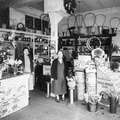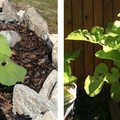Post-war babies born in the internment camps should be considered the ‘Lucky Ones’? These children didn’t suffer the whole forced removal ordeal beginning in 1942. They were born in Greenwood, New Denver, Kaslo, Slocan City or Lillooet where there were hospitals. There were several Nisei doctors serving in those areas.
As for myself, I didn’t know that I was living in an ‘internment camp’. Greenwood was the first internment site and the Nikkei families were placed mostly in old hotels right downtown. Slocan-New Denver area camps were segregated. Kaslo’s situation was similar to Greenwood. Our parents never really sat down with the children to explain what had happened. Fathers were too busy making a living and supporting the family, and mothers with many children were too busy with laundry, cooking and cleaning. Besides, I don’t think they wanted to bring up the negative part of their lives. Therefore, most children were sheltered from knowing the Nikkei history. To my knowledge, life went on as usual and I never encountered any elderly person being bitter or angry, deep inside, maybe.
Our young lives began around 1950. One day, I would see my friend in kindergarten, the next day he was gone. 1949 was the year the federal government allowed Nikkei people their freedom. Some of the fishermen families in Greenwood moved back to Steveston to resume their occupation. Handful went to Japan and others went east to the Toronto and Montreal area. However, most of the Nikkei families in Greenwood were fortunate that they were not pressured to move out of the community. The Board of Trade wrote a letter of protest to keep the ‘new’ residents in Greenwood.
City of Greenwood was in a narrow valley surrounded by mountains. The east side was green with forest and ranch land. The west side, especially Mt. Jubilee, was rocky. Little did I realize that the old copper processing smelter in the early 1900’s destroyed most of the trees nearby. Nevertheless, the mountains provided a bountiful, natural outdoor playground for the children. Boundary Creek and Jewel Lake offered water activities. The man-made woodsheds were the children’s hang-out. Every day, town kids gravitated to the woodsheds behind #5-7-11(Miller-Mellor) buildings and other times behind #4 (Rendell Block) building. Greenwood maintained the status of a city even though the population hovered around a thousand, thus, it was the smallest city in Canada.
SPRING: In early March, snow would be slowly melting. Water from the hills trickled underneath the snow. This was the best time to build a ‘Snow Dam’. Little children with their garden shovels worked like busy bees to pack the snow to make dams to stop the water from flowing onto the main street. Meanwhile, the older kids worked like busy beavers up the hill on Greenwood Street beside Sacred Heart School. They packed the snow right across the road! One could just imagine how much water was stored in a short time. Suddenly, the big boys would smash the dam and the pent-up water came raging down the road like tsunami and wiped out all the little children’s dams down below! The big boys were laughing their heads off. Most of the little ones were Catholics so they didn’t know how to swear. Moreover, they didn’t want to say ten Hail Mary if they did!
Once the snow completely melted, the children of all ages pursued their love of making dirt dams down that same street. Remember, most of the streets were unpaved back then.
The moist sand and dirt on the road by April was a great place to play marbles. Marking the lines in the dirt with a sharp stick was clearly visible. Children played for ‘Funs or Keeps’. ‘Funs’ meant the winner returned all of the marbles back to the owners after each round. There was ‘Big Shot’ and ‘Little Shot’. Beginners used ‘Little Shot’ where the player made the index finger into a ‘U’ shape and the thumb propelled the marble. ‘Big Shot’ was when the shooter made a ‘V’ with the index finger to get more speed and power. Cheaters would slyly bring out their ‘steelies or dongos’ to take out the oppositions’ marbles. They were bigger, heavier kind that were twice as large as normal marbles. There were shouts of arguing, and crying.
You could always tell a ‘Marble Shark’. This boy carried all his marbles in a purple Seagram whiskey velvet bag! In the marble world, was that bag a sign of a gunslinger in the Old West? One exception, there was this little 10-year old girl who outshot all the boys in the neighbourhood!
Springtime was for a daily game of softball. It wasn’t sandlot ball, but more like sawdust and mulch, make-shift playground behind rows of woodshed. The infield was like the rolling hills in the prairies and there were big rocks sticking out so fielding a grounder was an adventure. Government Street was left field and the neighbour’s front rock wall was our ‘Green Monster’, right field had a large boulder and Saskatoon berry bush. Our dugout was the sawdust or woodshed opening. There was always one boy who owned a ball or a bat. Now, we didn’t dare call him ‘Out’ because he would take the ball and go home. Game over!
Creek level in the spring was high and it was too cold for swimming. Children had this challenge. They would all make canoes out of cigarette tinfoil or carve small sailboats. Contestants released their boats at First Bridge. Then, they ran as fast as possible to Second Bridge to collect rocks and small boulders. As the boats came into view, all the kids threw rocks and boulders from the bridge to sink their opponents’ boats. The owners’ boats that escaped the bombardment past the bridge won.
This was a story of about some boys coming of age, so to speak. Most Nikkei families living in the apartments didn’t have a private bath or ofuro. They had to pay to go to a public bath. Therefore, many of the teenage girls came to our house to join my four sisters for a hot bath. One could feel the level of testosterone in the air! Some of the boys tried to look for any cracks in the door. The door was old and had a long sliver of a crack. One boy was pressing as hard as possible to see if he could get a glimpse of this one voluptuous young lady but to no avail. Few more boys climbed the woodpile, but dad had a heavy curtain to block the view.
Then, this one easy-going boy came up with a brilliant idea. There was a round hole in the floor where the washing machine drain pipe once was, and dad had removed the broken down machine the week before. Fortunately, there was an opening of about four inches in diameter. Unfortunately, the boys couldn’t get the proper angle to see anything. This young teen ran home to get his home-made Corn Flakes box periscope! The mirrors were placed in such a way that the periscope worked well. Up went the periscope! All you could hear was screams and screeches! I was a little boy watching all of this! That boy as an adult said that my sister gave him the hardest punch ever. Dem were the days.
© 2017 Chuck Tasaka






